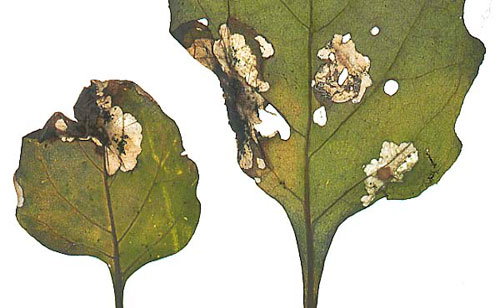|
||||||
|
NICOTIANA. Tobacco. [Solanaceae] |
|
|
Fifteen species of Nicotiana are recorded in Britain. All are introduced and include Sweet Tabacco (N. alata), Red Tobacco (N. forgetiana), Wild Tobacco (N. rustica) and Tobacco (N. tabacum). Four British miners are recorded on Nicotiana. A key to the European miners recorded on Nicotiana is provided in Bladmineerders van Europa. |
Key for the identification of the known mines of British |
1a > Leaf-miner: A distinctive mine primarily above mid-rib, with irregular short lateral offshoots into leaf blade. Pupation external (Spencer, 1972: 51 (fig. 172), 55; Spencer, 1976: 270, 271 (fig. 486)). Branched, whitish, upper-surface corridor; main axis overlying the midrib; side branches overlying the main lateral veins. (In Campanula and Phyteuma the mine is much less branched, sometimes nothing more than a corridor on top of the midrib). Frass in rather long strings. Usually the mines begins as a long and narrow, shallow, tortuous lower-surface corridor that ends upon the midrib but otherwise is not associated with the leaf venation. Often this initial corridor is filled with callus, and then even less conspicuous. Pupation outside the mine. A linear mine on the upper surface, usually following the midrib and showing side branches along the veins. The frass is in strings. |
|
Liriomyza strigata (Meigen, 1830) [Diptera: Agromyzidae]. |
1b > Leaf-miner: A short, irregular, linear upper surface mine on any part of the leaf, indistinguishable from the mine of Liriomyza sativae. |
|
Liriomyza bryoniae (Kaltenbach, 1858) [Diptera: Agromyzidae]. |
1c > Leaf-miner: Mine linear, whitish, both upper and lower surface. Pupation internal, at the end of the mine with the anterior spiracles projecting through the epidermis (Spencer, 1976: 433). Upper-surface, less often lower-surface corridor. Frass in isolated grains. Pupation within the mine, usually in a lower-surface puparial chamber. A long whitish upper surface corridor, which eventually goes lower surface. |
|
Chromatomyia horticola (Goureau, 1851) [Diptera: Agromyzidae]. |
1d > Leaf-miner: Large, glassy, irregular blotches without a recognisable preceding corridor. Frass in a black mass, mainly in the oldest part of the mine. The larvae move several times, and can also bore in the stem and underground parts. |
 Mine of Phthorimaea operculella on Solanum nigrum Image: © Willem Ellis (Bladmineerders van Europa) |
|
| Phthorimaea operculella (Zeller, 1873) [Lepidoptera: Gelechiidae]. |
| Last updated 06-Jul-2019 Brian Pitkin | ||
